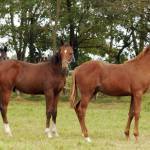Dietary Protein for Growing Horses

Protein requirements for growth in horses are primarily determined by requirements for the amino acids contained in the protein. Studies on lysine, one of the most important amino acids for growth requirements in horses, show that the ratio of lysine to digestible energy varies widely with differences in growth rates. Studies of other amino acids in growing horses are limited.
Weight gains of 1.5 to 1.75 lb (0.68 to 0.79 kg) per day are usually satisfactory for six-month-old foals. However, higher lysine levels are needed in rations for orphan foals or early-weaned foals and in creep feeds, especially if mare milk is severely restricted. The protein level required to meet the amino acid requirements is determined by the amino acid content and availability in the ingredients used in the ration. If a significant amount of high-protein hay is fed, the protein level in the grain feed may not need to be as high.
Lysine is the first limiting amino acid in typical horse ration ingredients and if the lysine requirement is met using these ingredients, the requirements for the other amino acids will likely be met. If large amounts of unusual ingredients or synthetic amino acid supplements are used, then levels of other essential amino acids may be a concern. A recent study in yearling horses showed that threonine at 80% of the lysine level was adequate. Adequacy of other essential amino acid levels should be evaluated in animal studies and/or by comparing to known requirements in simple-stomached species such as swine, rats, and humans.
Lowering protein levels to reduce growth rates in an attempt to help with developmental orthopedic disease (DOD) problems in young horses has been a common recommendation in the horse industry. This practice will reduce weight gains as well as bone growth as measured by wither height. There is no question that gross overfeeding or overconsumption of grain feeds will help precipitate DOD problems in susceptible horses. However, there are no definitive data showing that high protein levels in feeds are likely to raise the incidence of DOD problems. Avoiding feeds with a high glycemic response is a more helpful practice to avoid skeletal problems in growing horses.
Practical experience with numerous feeding trials, controlled and uncontrolled, indicate that selection of the proper ration for the class of animal with respect to its amino acid and mineral content, and feeding the ration at the recommended level, will result in minimal DOD problems. There should be a concern of how nutrient restrictions will affect the expression of the genetic potential of the horse for size and structure. Reducing protein intake without a concurrent reduction in caloric intake should change the composition of gain to more fat and less muscle. If possible, it would be preferable to reduce both caloric and protein intake and try to maintain a normal muscle and fat content at the lower rate of gain.








